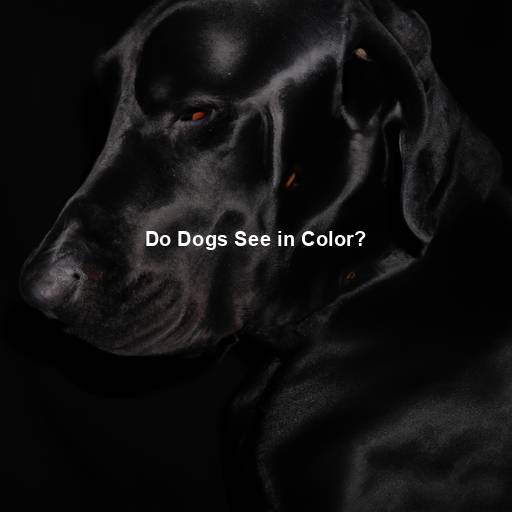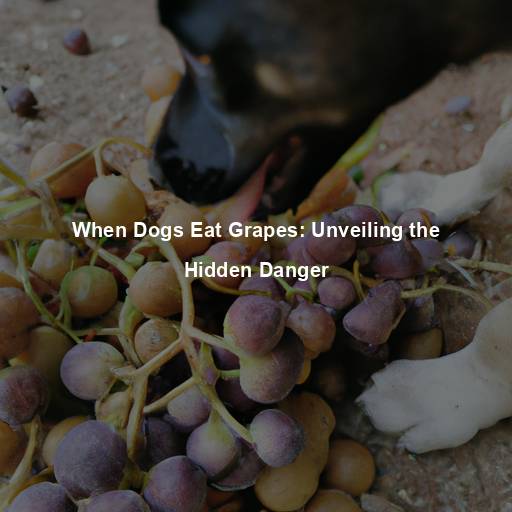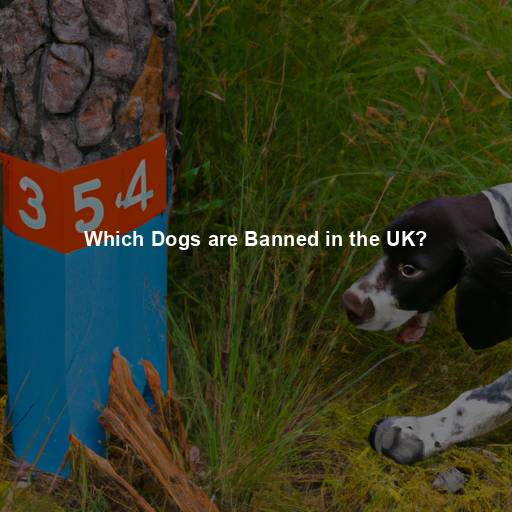Do Dogs See in Color?
Last Updated on July 11, 2023 by Evan
Contents [hide]
- 1 Understanding Canine Vision: Debunking the Myth
- 1.1 Unveiling the Myth: Dogs and Color Perception
- 1.2 The Science Behind Canine Color Vision
- 1.3 Shades of the Canine Rainbow: Which Colors Can Dogs See?
- 1.4 A World of Scent and Motion: Dogs’ Primary Senses
- 1.5 The Evolutionary Aspect: Why Dogs See Differently
- 1.6 The Role of Genetics: Breed Variations in Color Perception
- 1.7 The Human-Dog Connection: Appreciating Our Differences
- 1.8 The Influence of Light Intensity
- 1.9 The Impact of Color Contrast
- 1.10 The Role of Training and Conditioning
- 2 Debunking Common Misconceptions
- 3 Enhancing the Canine Visual Experience
- 4 Embracing Canine Individuality
- 5 A Kaleidoscope of Canine Vision
- 6 FAQs: Do Dogs See in Color
Understanding Canine Vision: Debunking the Myth
When it comes to our beloved furry friends, there are often many questions that arise regarding their abilities and perceptions. One of the most common inquiries is whether or not dogs see in color. It’s a fascinating topic that has sparked curiosity and debate among pet lovers and experts alike. In this article, we will delve into the world of canine vision, separating fact from fiction, and exploring the unique way dogs perceive the world around them.
Unveiling the Myth: Dogs and Color Perception
It has long been believed that dogs see the world in shades of black and white, devoid of the vibrant colors that humans experience. However, recent studies have shed new light on this notion, revealing that dogs do, in fact, have some capacity for color vision. While not as extensive as our own, their visual spectrum encompasses a limited range of colors.
The Science Behind Canine Color Vision
When it comes to unraveling the enigmatic world of canine color perception, a journey into the intricate anatomy of their eyes is indispensable. Like us, our canine companions possess those fascinating photoreceptor cells called cones that work their magic in deciphering the vibrant tapestry of colors. But here’s where it gets intriguing: while we humans bask in the glory of a trichromatic vision, dogs embark on a slightly different visual adventure with a dichromatic vision, equipped with only two types of cones. So let’s dive deeper into this perplexing realm and uncover the complexities of how dogs perceive the kaleidoscope of colors that surrounds them.
Shades of the Canine Rainbow: Which Colors Can Dogs See?
While dogs may not see the world in full technicolor, they are not entirely colorblind. Their visual perception is skewed towards shades of blue and yellow, with limited differentiation between red and green. This means that dogs are most likely to perceive the world as a range of blues, grays, and yellows. The vibrant red of a rose or the lush green of grass may appear less vivid to our canine companions.
A World of Scent and Motion: Dogs’ Primary Senses
It’s fascinating how, despite their limited color perception, dogs possess a realm of heightened senses that leaves us in awe. One of their standout abilities lies in their olfactory prowess, surpassing our own by leaps and bounds. They can pick up on scents that elude our human senses, unlocking a hidden world of aromas. But it doesn’t stop there – their remarkable knack for tracking movement makes them both exceptional hunters and loyal companions, constantly keeping us perplexed by their skills.
The Evolutionary Aspect: Why Dogs See Differently
Delving into the fascinating world of canine color vision reveals an entangled web of evolutionary marvel. By tracing our loyal companions’ origins back to their wild ancestors, the wolves, we uncover a shared trait: a distinctive dichromatic vision. This extraordinary sight was once an asset in the untamed wilderness, enabling them to discern quarry amidst nature’s tapestry. As the sands of time trickled, dogs peacefully embraced evolution, yet their visual acuity remained steadfast, an intriguing glimpse into a complex journey.
The Role of Genetics: Breed Variations in Color Perception
While dogs, in general, have a limited color spectrum, it’s important to note that there can be variations within different breeds. Some dog breeds may have a more pronounced ability to perceive colors, while others may have more significant limitations. Factors such as the number and distribution of cones in their retinas can contribute to these variations.
The Human-Dog Connection: Appreciating Our Differences
Understanding the unique perspectives of our furry friends is crucial for pet owners, as it allows us to appreciate the diverse ways in which dogs experience the world. While we may be enamored by the kaleidoscope of colors in a sunset, dogs find bliss in the sensation of the soft grass under their feet or the enticing aroma of a newly baked treat. Accepting and celebrating these disparities not only enriches our comprehension of our canine companions, but also forges a stronger connection between us and them.
The Influence of Light Intensity
While dogs may have a limited color spectrum, their visual perception is also influenced by the intensity of light. Dogs have a higher sensitivity to dim light compared to humans, which allows them to navigate and see more clearly in low-light conditions. This adaptation is a result of their evolutionary history as nocturnal hunters and scavengers.
The Impact of Color Contrast
When it comes to spotting objects against different backgrounds, dogs have a fascinating edge over humans. While their color vision may not be as sharp, their sensitivity to variations in brightness is off the charts. Picture this: a vibrant yellow tennis ball against a lush green grassy backdrop. It pops out like a shining star to a dog, even if they may not see its true color as we do.
The Role of Training and Conditioning
Dogs, captivating creatures that they are, possess inherent visual talents that shape their unique perceptions and responses. However, it’s no small wonder that their upbringing and training equally influence their visual experiences. By skillfully guiding and conditioning their furry friends, humans can introduce colors and visual triggers that trigger specific behaviors and commands. It’s truly awe-inspiring to witness how dogs seamlessly adapt and absorb knowledge in our complex human universe.
Debunking Common Misconceptions
Myth: Dogs Only See in Black and White
Contrary to popular belief, dogs’ visual capabilities extend beyond the realms of black and white. Although their color perception is not as extensive as ours, dogs can actually discern specific shades within their limited spectrum, particularly focusing on blues and yellows. It is fascinating how their visual realm showcases a vibrant array of tones that awakens curiosity and challenges common misconceptions.
Myth: Dogs Cannot Distinguish Red and Green
It’s quite fascinating to learn that dogs don’t see red and green as separate and vibrant hues like we do. Their perception of red is akin to a warm yellow or rich brown, while green appears more like a muted shade of gray to their eyes. Even though the differentiation might not be as pronounced as it is for us, dogs still possess the ability to discern subtle contrasts in these colors to a certain degree. It perplexes me how their visual world can be so distinct from ours, yet they navigate it with such ease.
Myth: Dogs’ Color Vision is Inferior
Labeling dogs’ color vision as inferior is a misconception that stems from comparing it to human vision. Dogs have evolved with a visual system that caters to their specific needs, which prioritize other senses such as smell and motion detection. While their color perception may not be as extensive as ours, it is perfectly suited for their lifestyle and environment.
Enhancing the Canine Visual Experience
Understanding What Dogs Can See
In order to truly grasp the visual journey of our beloved furry counterparts, it becomes imperative for us to immerse ourselves in their unique perspective. By acknowledging the distinctive manner in which they perceive their surroundings, we can meticulously craft an environment that is both captivating and cozy for them. Here are some intriguing pointers to help you embark on this enlightening endeavor:
- Contrasting Toys: Choose toys and objects with high color contrast to make them more visible to your dog.
Enhance your furry friend’s playtime with an aromatic twist! Engage their senses by introducing scent-based activities, like a game of hide-and-sniff for treats or enticing them with scented toys. Watch as their primary sense takes center stage, unraveling a world of excitement and curiosity that will leave them bursting with joy and begging for more! It’s time to embark on an olfactory adventure that will surely perplex and captivate your beloved companion. - Consider Lighting: Be mindful of the lighting conditions in your home and outdoor spaces to ensure optimal visibility for your dog.
The Importance of Non-Visual Cues
As pet owners, we often forget that our furry companions rely on more than just their eyes to make sense of the world around them. Dogs, in particular, have an innate ability to use their senses of smell, sound, and touch to navigate their surroundings. By taking into account these non-visual cues and incorporating them into their training and daily interactions, we can create a truly enriching and holistic experience for our beloved pets. It’s fascinating to witness how dogs perceive their environment through a symphony of scents, sounds, and textures, and by embracing their multisensory nature, we can deepen the bond we share with our furry friends.
The Bond Between Humans and Dogs: Beyond Visual Perception
The fascinating connection we forge with our beloved furry friends is an intricate tapestry that transcends the mere realms of visual perception. Its foundations lie in a delicate tapestry woven with trust, adoration, and an indescribable harmony. In this beautiful dance of companionship, our four-legged allies depend on us, and in turn, we are eternally grateful for their unyielding dedication and camaraderie. Be it colors or shades, our bond is unbreakable and immeasurable, unyielding to the perplexities of perception.
Embracing Canine Individuality
As we dive into the fascinating world of our furry companions, we come face to face with the astounding variety of our canine friends’ visual prowess and personal tastes. From keen puppies to wise seniors, each dog brings their own unique set of optical talents and preferences to the table. Age, wellness, and breed all play a significant role in shaping their distinct perspectives, urging us to embrace this diversity and create tailored experiences that cater to their individual visual needs.
A Kaleidoscope of Canine Vision
Embarking on a mesmerizing journey into the enigmatic world of canine perception reveals that dogs, though not privy to the same kaleidoscope of hues as humans, possess a visual acuity that transcends the realm of black and white. Their ability to perceive select colors within a limited spectrum adds an intriguing dimension to their view of the world. Yet, it is their heightened olfactory senses, motion detection prowess, and keen contrast sensitivity that truly add an astonishing layer of complexity to their visual experience. By delving deep into their unique way of seeing, we unearth a treasure trove of insights that strengthens our bond with these remarkable creatures and ensures their thriving amidst a visually diverse environment.
The Influence of Surrounding Environment
The world of dogs is an intriguing amalgamation of scents and sights, where their environment holds the power to shape their perception. These fascinating creatures, with their remarkable sense of smell, often rely on olfactory cues to navigate the world around them. However, we mustn’t overlook the significance of their vision, as it helps them detect motion and identify objects. Understanding the holistic sensory experience of our furry friends is key to truly comprehending their unique perspective.
The Effect of Size and Shape
Ever wondered why your furry companion seems to have a unique take on the world around them? Well, it turns out that dogs, with their lower vantage point, have a whole different perspective when it comes to perceiving the size and shape of objects. This intriguing revelation means that what may seem ordinary to us humans could be a whole new world of puzzlement and intrigue for our four-legged friends. By taking this into consideration, we can ensure a safe and stimulating environment that caters to their unique perception.
The Role of Visual Communication
Dogs communicate with us and other animals through a combination of vocalizations, body language, and visual cues. While their visual communication may not be as intricate as their vocalizations or body postures, it still plays a significant role in their interactions. Dogs may use direct eye contact, subtle facial expressions, or tail movements to convey their emotions or intentions.
Subheading: Tail Language: A Visual Indicator
One fascinating aspect of canine visual communication is the language of their tails. A wagging tail is often associated with happiness and excitement, but the position and speed of the wag can convey different messages. A high, fast wag may indicate enthusiasm, while a low, slow wag may suggest caution or uncertainty. Understanding these tail signals can help us better understand our dogs’ emotions.
The Human-Dog Bond: A Multisensory Connection
There’s something extraordinary about the bond we share with our furry companions. It goes beyond the surface, beyond what we can see. It’s as if our dogs have this innate sense, this sixth sense, to understand us in ways that words fail to capture. They can feel the energy emanating from us, interpret our slightest movements, and somehow offer solace when we need it most.
Enhancing the Canine Visual Experience
Discovering the realm of dogs’ visual perception seems to unveil a whole new world that promises to revolutionize their every day. The mere thought of enhancing their overall well-being by creating an environment that captivates their visual senses brings perplexity, yet excitement. Here, we present to you some intriguing and imaginative ways to optimize their visual experience, aiming to unlock a whole new level of engagement and contentment for our beloved four-legged companions.
Subheading: Enrichment Activities for Visual Stimulation
- Puzzle Toys: Provide interactive toys that engage their visual and problem-solving skills, such as treat-dispensing puzzles or hidden treasure games.
Enhance the effectiveness of your training sessions by incorporating positive reinforcement techniques. By incorporating visual cues, like hand signals, in addition to verbal commands, you can provide clear and consistent guidance to your furry friend, ensuring that they understand and exhibit the desired behaviors. This combination of visual and verbal reinforcement fosters a deeper understanding and connection between you and your pet, making training sessions more engaging and successful.
Upgrade your pup’s cognitive skills with an engaging visual training regimen that adds a splash of color and excitement to their routine. Unleash their inner detective by teaching them how to differentiate between a vibrant spectrum of objects, or watch in awe as they respond to specific visual cues like a seasoned pro. Enhance your bond with your furry friend while unraveling the mysteries of their perceptual prowess through the world of visual training.
Adapting to Canine Sensory Needs
As devoted guardians of our furry companions, it is of utmost importance to remain conscientious about our dogs’ sensory requirements and adapt accordingly. With each dog displaying their own distinct characteristics and sensitivities, it becomes pivotal to consider their individual preferences. By staying attuned to elements like lighting, color contrasts, and the sensory landscape that surrounds them, we can profoundly influence their overall welfare.
Embracing the Wonder of Canine Vision
In conclusion, dogs experience the world through a distinct visual lens that differs from our own. Their perception is shaped by their evolutionary history, the surrounding environment, and their individual sensory capabilities. By understanding and appreciating their visual perception, we can deepen our connection, enhance their well-being, and enrich their lives in ways that align with their unique sensory experience.
As we embark on a captivating exploration into the fascinating world of canine vision, let us revel in the tantalizing tapestry of perspectives and the extraordinary connection we forge with our beloved furry companions. Through unity and imagination, we hold the power to craft an enchanting and visually mesmerizing realm, where our cherished dogs can thrive and bask in a symphony of visual stimuli. Let us embrace this exhilarating adventure, as we unlock the secrets of their perception and deepen our bond like never before.
FAQs: Do Dogs See in Color
What colors can dogs see?
Contrary to what many people think, our furry companions, dogs, do have some ability to discern colors. Although their color perception is not as extensive as ours, they are not completely colorblind. Dogs navigate the world through a more muted palette, seeing shades of blues, yellows, and grays. Unlike humans, who possess three types of color receptors, dogs only have two, making it challenging for them to distinguish certain hues, particularly in the red and green range.
Can dogs see black and white?
Yes, dogs can see black and white. However, their vision is not strictly limited to these two colors. Dogs perceive the world in various shades of gray, which allows them to differentiate between different objects and recognize contrasts, even if they cannot see the full spectrum of colors like humans do.
Can dogs see red and green colors?
When it comes to seeing the world in color, our furry friends have a different perspective. Dogs, with their unique ocular structure, possess a somewhat reduced ability to perceive red and green hues compared to us humans. To them, the color red might appear as an enigmatic blend of gray and brown, while green might be transformed into a subtler shade of gray. Although dogs are still able to identify objects based on their varying shades, the vivid and vibrant spectrum of red and green that captivates our visual senses remains elusive to our four-legged companions.
Do dogs see the world differently than humans?
Did you know that dogs have a whole different way of seeing the world? It’s not just that their color spectrum is narrower than ours, but their visual acuity is also not as sharp. However, what they lack in visual clarity, they make up for in other ways. Dogs have an incredible ability to detect motion and see better in the dark, thanks to their specialized eyes. But what truly sets them apart is their heightened senses of smell and hearing. These senses take the lead, compensating for any visual limitations and allowing dogs to excel at sniffing out scents, tuning into sounds, and noticing even the slightest movements. It’s as if they have their very own superpowers that make them extraordinary creatures in their own right.
Are there any advantages to dogs’ color vision?
While humans might boast superior color vision, little do they know that dogs have their own unique visual talents. Although their perception of the world lacks the vibrancy of our own, canines possess a remarkable knack for differentiating between various shades of blue and yellow, making them excellent at spot-the-object games against diverse backgrounds. Moreover, their limited color spectrum empowers them to prioritize contrasts and movement, proving indispensable in activities such as hunting, tracking, and anything that demands keen visual acuity. So, despite their seemingly monochromatic world, dogs navigate a realm full of surprising hues and a perceptual prowess that continually astounds us.
Is there any way to improve a dog’s color vision?
No, there is no known way to improve a dog’s color vision. It is a natural characteristic determined by their genetics and the structure of their eyes. While dogs may not perceive colors with the same richness as humans, they have adapted to thrive in their environment using their other enhanced senses. Their color vision, although different, is well-suited to their needs.







